Side Menu:
Fourth Officer Joseph Boxhall
- Mystery Ship, Rockets and Ismay
While helping clearing the boats on the portside, Boxhall's attention was drawn to a light on the horizon - a 'mystery ship'. According to the US Inquiry he spotted it "shortly after the order was given to clear the boats." (US Inquiry)
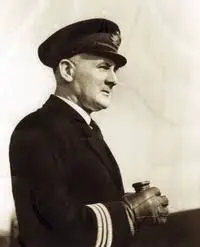
A later image of Boxhall, holding
a pair of binoculars as he did
aboard Titanic, observing a
'mystery ship'.
It was apparently one of the men on the bridge who reported it: "I heard someone report a light, a light ahead. I went on the bridge and had a look to see what the light was… I do not know who reported it. There were quite a lot of men on the bridge at the time….It was two masthead lights of a steamer… I could see the light with the naked eye, but I could not define what it was, but by the aid of a pair of glasses I found it was the two masthead lights of a vessel, probably about half a point on the port bow, and in the position she would be showing her red if it were visible, but she was too far off then. (British Inquiry)
In 1959 Boxhall identified the 'men on the bridge' who reported it as coming from the lookout:
"As he completed his [lifeboat] section, he heard the look-out bell sound again, and went back on to the bridge. Through his telescope he verified the report as being another ship, and informed the captain. He was told to keep an eye on it; and when he asked if he should send up some rockets, was told to do so. He ascertained that this ship was under way and coming towards them." ("A Talk by the Fourth Officer of the Titanic", May 1959, Nautical Magazine, pages 262 - 264)
In 1962 the starting position of the mystery ship that he described in 1912 as "half a point on the port bow" changed to the "starboard bow":
"I worked on the boat covers, taking off the boat covers, on the Boat Deck, when I heard the Crow's Nest report a light on the Starboard Bow. Well I went on the bridge right away, and I found this light with my own glasses but I wanted the telescope to define what it was and I realized then it was two masthead lights of a steamer below the horizon and the lights were very close and I went back and told the Captain, “There is a steamer insight very nearly ahead but slightly on the Starboard Bow and if she continues on her course she'll pass close to us down the Port Side.” (BBC, 1962)
12:20am Chartroom position
After clearing the port side lifeboats Boxhall then went into the chartroom to work out Titanic's position: "Then I went into the chart room and worked out the ship's position. I was clearing boats for a little while, and then went in and worked the position out." (US Inquiry). The sequence was also mentioned at the British Inquiry: "After seeing the men continuing with their work I saw all the officers were out, and I went into the chart room to work out its position." (British Inquiry). He also mentioned it was after spotting the mystery light: "It was after that, yes, because I must have been to the Marconi office with the position after I saw the light." (British Inquiry)
This was not the first position to be sent out, as Captain Smith had already sent out a CQD ten minutes prior to Boxhall's calculation. Captain Smith placed her at Latitude 41-44' North, Longitude 50-24' West. This was based on Fifth officer Lowe's estimate. Boxhall believed he knew why the Captain's position was wrong:
The Captain said, “I've already sent a distress signal.” “What, what position did you send it from?” He said, “From the eight o'clock DR.” “Well,” I said, “that was about, she was about twenty miles ahead of that sir. If you like I will run the position up from the star position up to the time of the contact with the ice berg.” (1962, BBC broadcast)
Boxhall began his calculations based on the 7.30pm position calculated earlier in the evening: "From the 7.30 position I allowed a course and distance which gave the position. I worked it out for 11.46 as a matter of fact." (British Inquiry) Boxhall assumed a speed of "twenty-two knots." between the 7.30 position and the time of collision. "I never depend on the patent log at all. It was an estimate that I had arrived at from the revolutions, although I had had no revolutions that watch; but, taking into consideration that it was smooth water and that there ought to have been a minimum of slip, I allowed 22 knots." (British Inquiry)
Every four hours reports of the number of revolutions was sent up from the engine room to the bridge. However Boxhall has "no immediate recollections of what the revolutions were at 8 o’clock. I do not remember them. As a matter of fact, I never received them. The Sixth Officer, when we went on watch, generally took them from the telephone."
Nonetheless, Boxhall remembered the position he calculated and was able to quote it at the US hearings: "Yes; I have the position… I have it in my head... Forty-one, forty-six, north; fifty, fourteen west….that was the position at the time she struck. She would just drift a little way farther on, probably half a mile or so. " (US Inquiry). As determined by the British Inquiry this was: "41º 46’ N., 50º 14’ W." (British Inquiry)
Wrong sinking position
As it happened, with the discovery of the wreck, at 41º 43’ N, 49º 56’ W, we now know that both Captain Smith's and Fourth officer Boxhall's positions are respectively 20 miles and 13 miles too far to the west of Titanic's actual sinking position.
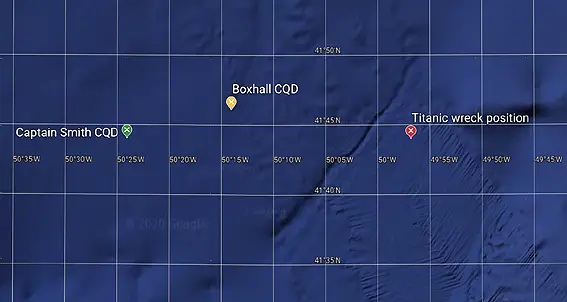
A comparison of the first distress call position give by Captain Smith and Boxhall's revised position, compared to the actual sinking location. They are respectively 20 miles and 13 miles too far to the west (Click image to enlarge)
The possibility of an inaccurate position was first raised at the US Inquiry, when Senator Burton asked Boxhall about the captain of the Mount Temple who believed Titanic was "eight miles" away from the reported position. But Boxhall replied that Captain Rostron of the Carpathia said Boxhall's calculation was a "splendid position" and it was based on Lightoller's "beautiful observations" earlier in the evening:
Senator BURTON: The captain of the Mount Temple maintains that the course as conveyed by the distress signal was wrong; that the Titanic was actually eight miles distant from the place indicated. What do you say as to that?
Mr. BOXHALL: I do not know what to say. I know our position, because I worked the position out, and I know that it is correct. One of the first things that Capt. Rostron said after I met him was "What a splendid position that was you gave us."
Senator BURTON: You gave them what position?
Mr. BOXHALL: 41º 46', and 50º 14'.
Senator BURTON: And you are satisfied that was correct?
Mr. BOXHALL: Perfectly.
Senator BURTON: You computed it yourself, did you?
Mr. BOXHALL: I computed it myself, and computed it by star observations that had been taken by Mr. Lightoller that same evening; and they were beautiful observations...
Senator BURTON. And the result as to the position of the ship was arrived at by computing your speed after 10 clock to the time of the collision?
Mr. BOXHALL. Yes.
Senator BURTON. You are very sure it was right, and Capt. Rostron said it was?
Mr. BOXHALL. Capt. Rostron said it was a very, very good position.
(US Inquiry)
12:35am Marconi room
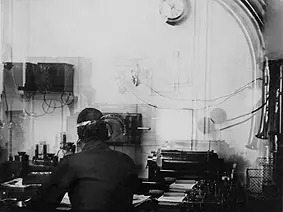
Titanic's wireless Marconi room where
Boxhall gave the ship's position to operators Phillips
and Bride (Click image to enlarge)
Once he had calculated the position he then reported it to Captain Smith: "I submitted her position to the captain…He said, 'Take it to the Marconi room.' ... I found the two operators there... Phillips and Bride... There was too much noise of the steam escaping, so I wrote the position down for them and left it….Left it on his table there. He saw it. He made a call, and he was listening, and I did not interrupt him." (US Inquiry) Boxhall later clarified that writing it down was normal practice anyway as "the wireless operator had the receivers on his ears. It is the usual thing, whenever I go into a Marconi office, and the operators are busy listening, not to interrupt them. Whatever I have to say I write down." (US Inquiry)
According to his 1962 BBC broadcast, Boxhall also mentions a brief conversation with Phillips:
"And because, I said, she was about twenty miles ahead of our position, amended this position and took it down to the wireless room, and Phillips the wireless operator was bending over his instrument, the telephone, holding the telephone, he says, “I'm in contact with the Carpathia.” Well I put the amended position down on the desk, and I said, “Now send that amended position. Do you understand?” He said, “Yes.” “Well,” I said, “send that off right away.” And that was the position the Carpathia came to."" (BBC interview October 1962)
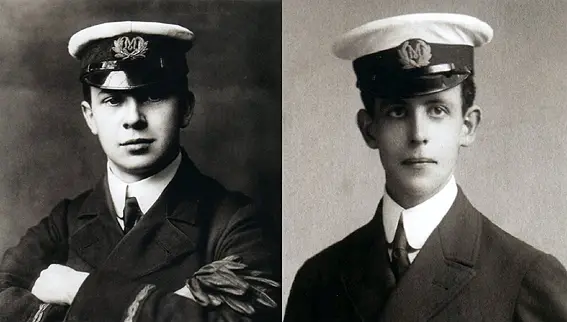
Marconi wireless operators Jack Phillips (left) and Harold Bride (right). According to Boxhall, Phillips told him "I'm in contact with the Carpathia." (Click image to enlarge)
After visiting the wireless room, Boxhall returns to the boat deck and continues to help "around the decks assisting to clear the decks and send distress signals off. " He notices some men and women passengers - " I think all of them had life preservers that I saw." (US Inquiry)
12:45am Distress Rockets
Of all the activities Boxhall was involved in while aboard Titanic in those final hours, he was most involved in launching distress rockets than anything else: "My attention until the time I left the ship was mostly taken up with firing off distress rockets and trying to signal a steamer that was almost ahead of us." (US Inquiry) The "steamer" Boxhall described as "almost ahead of us" and he "saw his masthead lights and I saw his side light... By the way she was heading she seemed to be meeting us." (US Inquiry).
As the "steamer" got closer, Boxhall could make out more detail: "At first I saw two masthead lights of a steamer, just slightly opened, and later she got closer to us, until, eventually, I could see her side lights with my naked eye… I considered she was about 5 miles away... She was headed toward us, meeting us… Just about half a point off our port bow... she got so close I could see her side lights and starboard light." (US Inquiry)
Boxhall went on to give even more specific details about the mystery ship:
Senator FLETCHER. What kind of steamer was that which you saw, that apparently turned around, as to size and character?
Mr. BOXHALL. That is hard to state, but the lights were on masts which were fairly close together - the masthead lights.
Senator FLETCHER. What would that indicate?
Mr. BOXHALL. That the masts were pretty close together. She might have been a four-mast ship or might have been a three-mast ship, but she certainly was not a two mast ship.
Senator FLETCHER. Could you form any idea as to her size?
Mr. BOXHALL. No; I could not.
Senator FLETCHER. You know it was a steamer and not a sailing vessel?
Mr. BOXHALL. Oh, yes; she was a steamer, carrying steaming lights - white lights.
Senator FLETCHER. She could not have been a fishing vessel?
Mr. BOXHALL. No, sir.
Senator FLETCHER. Was she a sailing vessel?
Mr. BOXHALL. No, sir; a sailing vessel does not show steaming lights, or white lights...
Senator BURTON: You are very positive you saw that ship ahead on the port bow, are you?
Mr. BOXHALL: Yes, sir, quite positive.
Senator BURTON: Did you see the green or red light?
Mr. BOXHALL: Yes; I saw the side lights with my naked eye...
Senator BURTON: Which light did you see first?
Mr. BOXHALL: I saw the masthead lights first, the two steaming lights; and then, as she drew up closer, I saw her side lights through my glasses, and eventually I saw the red light. I had seen the green, but I saw the red most of the time. I saw the red light with my naked eye.
Senator BURTON: Did she pull away from you?
Mr. BOXHALL: I do not know when she turned; I cannot say when I missed the lights, because I was leaving the bridge to go and fire off some more of those distress rockets and attend to other duties.
Senator BURTON: Then your idea is that she was coming toward you on the port side?
Mr. BOXHALL: Yes.
Senator BURTON: Because you saw the red light and the masthead lights?
Mr. BOXHALL: Yes, sir.
Senator BURTON: Afterward you saw the green light, which showed that she had turned?
Mr. BOXHALL: I think I saw the green light before I saw the red light, as a matter of fact. But the ship was meeting us. I am covering the whole thing by saying the ship was meeting us.
Senator BURTON: Your impression is she turned away, or turned on a different course?
Mr. BOXHALL: That is my impression. (US Inquiry)
Boxhall at first used binoculars to observe the ship: " I was paying most of my attention to this steamer then, and she was approaching us; and then I saw her sidelights. I saw her green light and the red. She was end-on to us. Later I saw her red light. This is all with the aid of a pair of glasses up to now. Afterwards I saw the ship’s red light with my naked eye, and the two masthead lights. The only description of the ship that I could give is that she was, or I judged her to be, a four-masted steamer... By the position of her masthead lights; they were close together." (British Inquiry)

Artist impression of Boxhall firing rockets from a children's book (Artist Peter Dennis, from the book "Titanic - The Disaster That Shocked the World" by Mark Dubowski).
Boxhall was also of the opinion that this mystery ship was still moving slowly towards them: "The ship on the port side was now clearly visible with portholes brightly shining, and contrary to the master's later given evidence, was still moving slowly." ("A Talk by the Fourth Officer of the Titanic", May 1959, Nautical Magazine, pages 262 - 264)
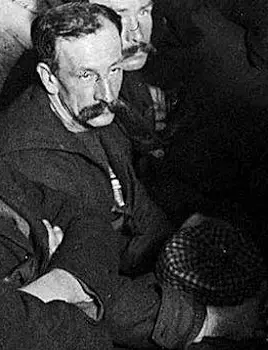
Quartermaster Arthur Bright testified about
bringing the distress signals to Boxhall
and helping to fire them.
In response Boxhall decides to fire distress rockets: "I had sent in the meantime for some rockets, and told the Captain I had sent for some rockets, and told him I would send them off, and told him when I saw this light. He said, “Yes, carry on with it.” I was sending rockets off and watching this steamer. Between the time of sending the rockets off and watching the steamer approach us I was making myself generally useful round the port side of the deck." (British Inquiry)
The rockets were brought by Quartermasters Rowe and Bright, from the after end of the ship:
Mr. BRIGHT. I went out to the after end of the ship to relieve the man I should have relieved at 12 o'clock, a man by the name of Rowe. We stood there for some moments and did not know exactly what to do, and rang the telephone up to the bridge and asked them what we should do. They told us to bring a box of detonators for them - signals. Each of us took a box to the bridge. When we got up there we were told to fire them - distress signals.
Senator SMITH. Who fired them?
Mr. BRIGHT. Rowe and I, and Mr. Boxhall, the fourth officer.
Senator SMITH. How long did you continue firing the rockets?
Mr. BRIGHT. Six were fired in all, I think.
Senator SMITH. One at a time.
Mr. BRIGHT. Yes, sir; at intervals.
Senator SMITH. At intervals of how long?
Mr. BRIGHT. I could not say. After we would fire one we would go and help clear the boats away, and then we would come back again.
Senator SMITH. This firing of rockets continued for some time, did it?
Mr. BRIGHT. I should say probably half an hour. (US Inquiry)
The rockets were fired from the forward starboard side of the ship in the bridge area: "I fired the distress signals from the socket in the rail just close to the bows of the emergency boat on the starboard side. Every time I fired a signal I had to clear everybody away from the vicinity of this socket, and then I remember the last one or two distress signals I sent off the boat had gone, and they were then working on the collapsible boat which was on the deck." (British Inquiry)
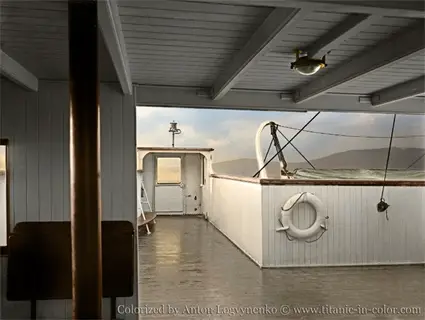
Titanic's starboard navigating bridge (colourised), where Boxhall, Rowe and Bright fired the distress rockets. (19.) (Click image to enlarge)

The precise position the rockets were fired from on the starboard boat deck, marked with a red circle (Deck plans: Honor & Glory)
Boxhall described the rockets as "exploded by a firing lanyard... They go right up into the air and they throw stars...They were quite satisfactory." (US Inquiry). When asked about the colour, he replied: "Just white stars, bright. I do not know whether they were stars or bright balls. I think they were balls. They were the regulation distress signals... not red. " (US Inquiry)
When asked if they would look like distress signals Boxhall replied: "I am hardly in a position to state that, because it is the first time I have seen distress rockets sent off, and I could not very well judge what they would be like, standing as I was, underneath them, firing them myself. I do not know what they would look like in the distance." (US Inquiry)
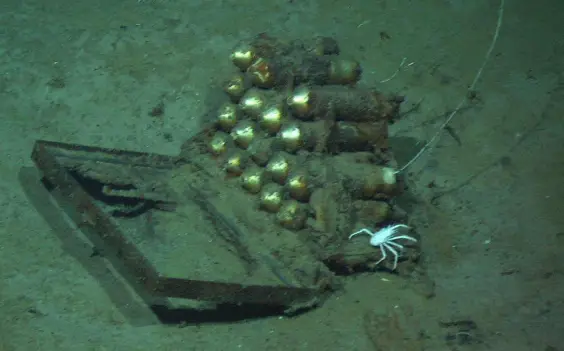
Box of Socket Distress Signals found at the Titanic wreck site.
Later in the British Inquiry he described the "distress signals... A shell bursts at a great height in the air, throwing out a great number of stars... Principally white, almost white... In the first place, the charge is no more and no less than what you would use in a 12-pounder or something like that. In the rail is a gunmetal socket. In the base of this cartridge, you may call it, is a black powder charge. The hole down through the centre of the remainder is blocked up with a peg. You insert the cartridge in this socket; a brass detonator, which reaches from the top of the signal into the charge at the base, is then inserted in this hole. There is a wire running through this detonator, and the pulling of this wire fires that, and that, in turn, fires the charge at the base of the cartridge. That, exploding, throws the shell to a height of several hundred feet, which is nothing more or less than a time shell and explodes by time in the air." (British Inquiry)
On another occasion he described seeing "a luminous tail behind them and then they explode in the air and burst into stars." (British Inquiry) As for the frequency of firing these rockets, Boxhall estimates "somewhere about eight at intervals of a few minutes - five or six minutes, or something like that..all fired from the starboard side, as far as I know." (British Inquiry) As to how many were fired, Boxhall later admitted: "I never knew how many I had fired. I knew very well that there were some in the box. The box holds a dozen and when, I told the Captain I said, “There are still some in there, sir, but I don't know how many I fired.” (1962, BBC) However in the British Inquiry he estimated he fired "between half a dozen and a dozen, I should say, as near as I could tell." (British Inquiry)
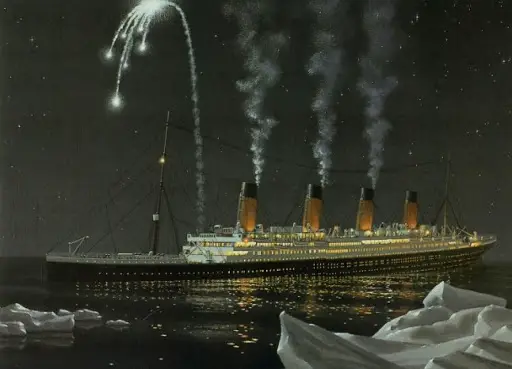
An artist's (Ken Marschall) impression of Titanic's distress rockets being fired from the starboard side.
Inbetween firing rockets Boxhall answered a telephone in the wheel-house of the bridge to say that one of the starboard ships had been launched, which he found surprising: "I knew one of the boats had gone away, because I happened to be putting the firing lanyard inside the well-house after sending off a rocket, and the telephone bell rang. Somebody telephoned to say that one of the starboard boats had left the ship, and I was rather surprised... I did not know the order had been given even to fill the boats. I reported it to the Commander." (British Inquiry)
He did not personally see it lowered but understood the first lifeboat to leave was "aft... on the starboard side" and does "not know who it was that told me through the telephone" but afterwards he "went outside again and was assisting generally... I went on the port side... Around forward." (US Inquiry)
Later, while firing further rockets from the starboard side of the bridge, Boxhall noticed emergency boat no.1 being loaded: "I saw some one filling the starboard emergency boat at the time that I went and was firing off rockets. I fired them just close to the bows of this emergency boat... but that one I noticed, because these distress rockets are dangerous things if they explode, and I had to keep people away clear while I fired the rockets." (US Inquiry). Later he mentioned that he "noticed other boats being filled, but I did not notice who was filling them. At such a time as that one does not stop to look who is doing things... as far as I can recollect, and from what I have heard, everything worked very smoothly in lowering the boats. (US Inquiry)
Morse Lamp
When the mystery ship seemed to appear closer, Boxhall then used the Morse lamps, located on both sides of the bridge, with Boxhall only using the one "on the port side" (British Inquiry)
He explained at the US Inquiry that Captain Smith was with him: "She got close enough, as I thought, to read our electric Morse signal, and I signaled to her; I told her to come at once, we were sinking; and the captain was standing... I told the captain about this ship, and he was with me most of the time when we were signaling... I went over and started the Morse signal. He said, "Tell him to come at once, we are sinking."... It was sent in the Morse key, the Morse code." (US Inquiry)
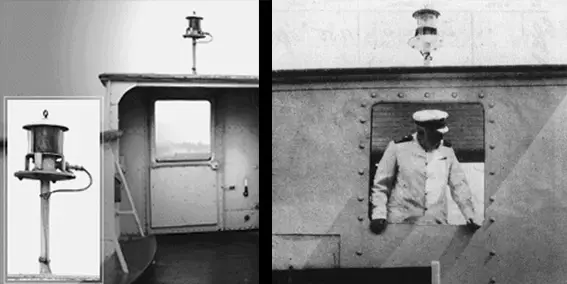
Some photographs showing what Titanic's Morse Lamp looked like. It was situated on top of the wing cab roof.
Boxhall later explained that the Morse code was delivered "by means of a telegraphic key and a Morse lamp. It is a series of dots and dashes… there is no reflection at all; it is just simply showing the light in and out - an electric light." (US Inquiry) He added that "as a matter of fact, Captain Smith was standing by my side, and we both came to the conclusion that she was close enough to be signaled by the Morse lamp. So I signaled to her. I called her up, and got no answer. The captain said, 'Tell him to come at once, we are sinking.' So I sent that signal out, 'Come at once, we are sinking.' "" (US Inquiry)
Whether there was a reply seemed to be a subject of some debate. "I cannot say I saw any reply. Some people say she replied to our rockets and our signals, but I did not see them... I cannot say that I saw any signals, except her ordinary steaming light. Some people say they saw signals, but I could not… People who were around the bridge... I think it was stewards…Some men said they saw her signals." (US Inquiry)
Boxhall looked through binoculars while he got Quartermaster Rowe who was assisting him to fire a rocket and use the Morse lamp. "There were a lot of stewards and men standing around the bridge and around the boat deck. Of course, there were quite a lot of them quite interested in this ship, looking from the bridge, and some said she had shown a light in reply, but I never saw it. I even got the quartermaster who was working around with me - I do not know who he was - to fire off the distress signal, and I got him to also signal with the Morse lamp - that is just a series of dots with short intervals of light - whilst I watched with a pair of glasses to see whether this man did answer, as some people said he had replied." (US Inquiry)
Captain Smith also used the binoculars - "Captain Smith also looked, and he could not see any answer." (British Inquiry)
Later in 1962 Boxhall also described using the "very powerful" Morse Lamp: "I didn't see any reply. Some of the passengers that was on the bridge said that they did see a reply. We also called up this ship as she grew closer with a, with a Morse Lamp, a very powerful Morse Lamp that we had, and eventually this steamer approached and approached until you could see all her lights with the naked eye and I should say that she must have been within five miles off, you could not only see her lights with the naked eye but you could see the lights in her portholes. So I reckon that she, she must have been within five miles. And then eventually she turned away and showed her stern light." (BBC interview October 1962)
Boxhall did not think the steamer was moving very fast: "I do not think she was doing much steaming. I do not think the ship was steaming very much, because after I first saw the masthead lights she must have been still steaming, but by the time I saw her red light with my naked eye she was not steaming very much. So she had probably gotten into the ice, and turned around. " (US Inquiry)
Boxhall does not think it was the Californian
Whether it was the Californian that Boxhall saw has been a subject of fierce debate. However it is interesting to note what he said at the inquiries when questioned on this. Firstly, he was sure about the distance: " I thought she was about 5 miles, and I arrived at it in this way. The masthead lights of a steamer are required by the Board of Trade regulations to show for 5 miles, and the signals are required to show for 2 miles… I could see quite clearly… I saw the side lights. Whatever ship she was had beautiful lights. I think we could see her lights more than the regulation distance, but I do not think we could see them 14 miles." (US Inquiry)
But then when Senator Smith posed the question that it could be the Californian and estimated the distance at 14 miles from the sinking ship, Boxhall dismissed the idea:
Senator SMITH. We have been figuring the distance the Californian was away from the Titanic, and from the positions given we have concluded - that is, we have evidence to support the theory - that the Californian was but 14 miles distant from the Titanic. Do you think that under those circumstances you could have seen the Californian?
Mr. BOXHALL. I do not know, sir. I should not think so.
Senator SMITH. You should not?
Mr. BOXHALL. No. Five miles is the distance the British Board of Trade requires masthead lights to show - that is, the white steaming lights of the steamer - but we know that they can be seen farther on such a clear night as that.
Senator SMITH. Suppose the Californian, 14 miles away, had been firing rockets for you and you had been on the bridge or on the boat deck, do you think you could have seen the rockets?
Mr. BOXHALL. Not at 14 miles; I should not think so. (US Inquiry)
However by the late 1950s, according to his descriptions given in 1959 and 1962, his opinion had changed to a belief that the ship they saw was indeed the Californian.
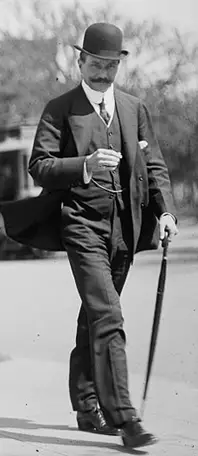
Bruce Ismay asked Boxhall:
'Why are you not getting the boat away?'
Conversation with Ismay
Towards the end of his time firing the distress rockets, "probably about ten minutes or a quarter of an hour before I came away in the boat", Boxhall encountered Bruce Ismay:
I talked to Mr. Ismay a little while before I left the ship. I do not know whether it was three quarters of an hour or not before the ship sank…. I had just fired a distress signal and was going to the chart room to put the lanyard back in the chart room and go out again, and Mr. Ismay was standing by the wheelhouse door... some of the boats had gone...He just came to the door on the bridge, as nearly as I can tell; walked up as far as the door. He was not there when I went to the lanyard; at least not when I went to fire the distress signal a moment before... He asked me why I was not getting the boat away... I told him I had no orders to get the boat away. I said the crew were ready and people were getting in the boat... I went on with my work. " (US Inquiry)
After Boxhall's reply, Ismay "passed on" and was "alone". (US Inquiry)